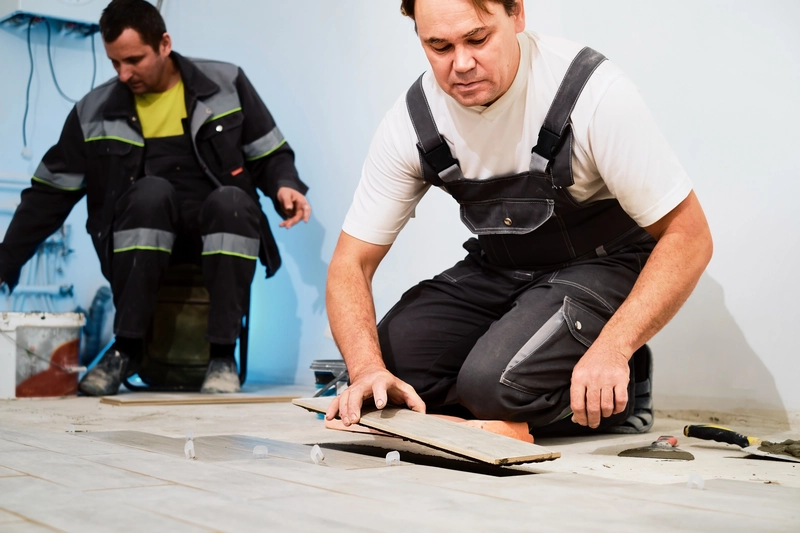Wondering which way to lay laminate flooring correctly? We discuss the factors to consider when laying laminate flooring, such as room shape and size, natural light, and existing flooring.
We explore the different ways you can lay laminate flooring, including horizontal, vertical, diagonal, and herringbone installations. Find tips for a successful laminate flooring installation to achieve a beautiful and durable result. Let’s get started!
Factors to Consider When Laying Laminate Flooring
To avoid common mistakes when laying laminate flooring, it is essential to consider several factors to ensure a successful installation, including room suitability, moisture levels, and the subfloor’s condition. Consulting experts can provide valuable insights into room-specific requirements and best practices for installation.
a. Room Shape and Size
The shape and size of the room significantly affect the layout and direction in which you should lay laminate flooring.
Regarding room dimensions, a larger room might benefit from a different layout than a smaller one. For example, wide rooms can be accentuated by laying the laminate flooring parallel to the longest wall, giving an elongating effect. Conversely, in narrower rooms, laying the planks perpendicular to the length can make the space appear wider.
Room proportions also play a crucial role in determining whether a horizontal or vertical layout would be more visually appealing. Irregularly shaped rooms may require creative solutions such as diagonal patterns or custom fitting.
b. Natural Light and Traffic Flow
Maximising natural light can create a sense of spaciousness and enhance the ambience of the space. By aligning the laminate planks parallel to the incoming light, you can visually expand the room.
Similarly, considering the pathways of foot traffic can help in choosing the most durable orientation for the flooring. Placing the planks perpendicular to the main entrance will help reduce wear and tear, as they will bear the brunt of the traffic head-on.
c. Existing Flooring and Subfloor
Assessing the existing flooring and subfloor is crucial before laying the laminate flooring, as it ensures the stability and longevity of the new installation.
Concrete subfloors, in particular, require special attention due to their unique properties and potential challenges they may present during the installation process.
These types of subfloors need to be thoroughly inspected for any cracks, moisture issues, or uneven surfaces that could impact the overall performance of the laminate flooring. Addressing any underlying problems before laying the new flooring is essential to prevent future headaches and ensure a smooth, flawless finish.
The Different Ways to Lay Laminate Flooring
There are several ways to lay laminate flooring, each offering distinct aesthetic and practical advantages. Understanding the different installation methods, such as horizontal, vertical, diagonal, and herringbone, will help you choose the correct way to lay laminate flooring.
a. Horizontal Installation
Horizontal installation is a popular method for laying laminate flooring, especially in smaller rooms, as it can create an illusion of width.
By having the laminate planks run horizontally across the room, the space appears broader, making it seem larger than it actually is. This visual trick is particularly beneficial in tight or narrow areas where you want to maximise the sense of openness.
Another advantage of this installation method is the seamless look it provides. With the planks running perpendicular to the longest wall, the floor appears continuous and uniform, enhancing the overall aesthetics of the room.
b. Vertical Installation
Vertical installation of laminate flooring can help make a room appear taller, making it an excellent choice for spaces with low ceilings.
Opting for vertical installation not only creates an illusion of higher ceilings, but it also enhances the overall spaciousness of the room. This technique is particularly beneficial in smaller rooms or those with limited natural light, as it opens up the visual expanse and imparts a sense of airiness. Vertical installation can complement various room types, from cosy bedrooms to modern living rooms, effortlessly transforming the look and feel of any space. Its versatility makes it a popular design choice among homeowners seeking to elevate their interiors.
c. Diagonal Installation
The diagonal installation offers a unique and visually striking layout for laminate flooring, adding a modern twist to any room.
One of the key aspects of diagonal installation is the way it can transform the perceived size of a room. Laying the flooring at a diagonal angle creates an illusion of a larger space, making it a popular choice for smaller rooms or areas where you want to create a sense of openness. The diagonal pattern adds dynamic energy to the room, drawing the eye in different directions and creating a more interesting visual experience.
d. Herringbone Installation
Herringbone installation creates a classic and sophisticated pattern with laminate flooring, making it a timeless choice for elegant interiors.
When undertaking a herringbone installation, there are several key steps to follow to achieve that striking visual effect. The planks need to be cut at precise angles to create the iconic V-shape pattern typical of herringbone flooring. Then, the planks must be laid out meticulously in alternating directions, requiring a keen eye for detail and precision to ensure the pattern flows seamlessly.
The visual appeal of a herringbone pattern lies in its ability to add depth and dimension to a space, creating a sense of movement and sophistication. The intricate design invokes a sense of luxury and elegance, making it a popular choice for high-end interiors.
Mastering the art of herringbone installation requires skill and patience. It demands careful planning, precise measurements, and expert craftsmanship to achieve a flawless finish. The intricate nature of the pattern means that even small mistakes can disrupt the overall look, highlighting the importance of attention to detail and a steady hand.


See product: Quick-Step Impressive Natural Pine
Which Way to Lay Laminate Flooring
Choosing the correct direction to lay laminate flooring is essential for both aesthetics and functionality. Factors such as the direction of natural light, the shape and size of the room, and the flow of foot traffic play crucial roles in making this choice.
1. Follow the Light Source
Following the natural light source when laying laminate flooring can enhance the visual appeal of the room by highlighting the grain and texture of the planks.
By aligning the laminate planks with the direction of the incoming light, you can create a seamless visual flow that accentuates the natural patterns in the flooring. This technique not only enhances the overall aesthetics of the room but also gives the illusion of a larger and brighter space.
Optimising the placement of the planks in relation to the light source can also affect the room’s ambience. Rooms with south-facing light will benefit from a warmer and cosier feel, while those with north-facing light will appear cooler and more refreshing.
2. Consider the Room’s Shape and Size
The shape and size of the room are significant factors in determining the direction to lay laminate flooring, as they influence the room’s overall appearance and proportion.
For example, in a long and narrow room, laying laminate flooring along the length of the room can create the illusion of a wider space. On the other hand, in a square or smaller room, laying the flooring across the width can make the room feel more balanced. In a room with prominent architectural features like a fireplace or large window, aligning the laminate flooring perpendicular to these features can enhance their presence.
3. Follow the Traffic Flow
Following the traffic flow when laying laminate flooring can enhance durability and ensure a natural walking path within the room.
To effectively assess the main traffic routes in a room, start by observing the natural movement patterns. Consider where people enter and exit the room most frequently and the paths they take.
High-traffic areas such as entrances, hallways, and around furniture should guide the placement of your laminate planks. By aligning the planks perpendicular to the primary traffic flow, you can distribute the wear evenly, preventing premature damage. This strategic approach not only improves the longevity of your flooring but also enhances the overall aesthetic appeal of the space.
4. Consider the Existing Flooring and Subfloor
Considering the existing flooring and subfloor condition is essential when deciding the direction for laying laminate flooring, as it affects stability and ease of installation.
The type and condition of the current flooring and subfloor can significantly influence the direction in which the laminate flooring should be laid. For instance, if the current flooring is hardwood or tiled, it may provide a more solid base making it suitable to run the laminate boards perpendicular to the existing floorboards for a visually appealing look. On the other hand, if the subfloor is uneven or requires leveling, additional preparatory steps such as using a self-leveling compound or underlay may be necessary before laying the laminate.
Tips for Laying Laminate Flooring
When laying the laminate flooring, following expert tips can make the installation process smoother and ensure a professional-looking finish. From starting in the right corner to using spacers and tapping blocks, these practical tips will guide you through each step.
1. Start from the Corner
Starting from the corner when laying laminate flooring helps establish a straight and consistent layout, making the installation process more manageable.
One of the key benefits of starting from the corner is that it sets a reference point that guides the rest of the installation. By ensuring the first row is perfectly aligned, you create a solid foundation for the subsequent rows to follow suit. This method not only enhances the overall appearance of the flooring but also minimises the chances of errors or misalignments.
Beginning from the corner allows you to address any potential issues early on, such as adjusting for uneven walls or obstacles along the way. This proactive approach can save time and effort during the installation process, resulting in a polished and professional finish.
2. Use Spacers
Using spacers during laminate flooring installation is crucial for maintaining an appropriate expansion gap around the perimeter of the room.
Expansion gaps are essential as they allow the flooring to expand and contract with changes in humidity and temperature, preventing buckling or warping. Spacers, typically made of plastic, are placed along the walls to create a consistent gap that ensures the flooring has room to move without causing damage.
Proper use of spacers is key to the longevity of your laminate floor. Placing them evenly around the room, especially in areas with high moisture levels like kitchens and bathrooms, can help prevent issues over time.
3. Use a Tapping Block
A tapping block is an essential tool for fitting laminate flooring, as it helps to secure the boards tightly without damaging the edges.
When using a tapping block, ensure that the groove side of the plank is facing outwards. Place the block against the edge of the plank and gently tap the block with a hammer to connect the planks seamlessly. The block distributes the force evenly, preventing any dents or scratches.
It’s important to maintain a consistent angle while tapping to avoid causing any misalignment or gaps between the planks. The tapping block plays a crucial role in providing a professional finish to your laminate floor installation.
4. Leave Room for Expansion
Leaving room for expansion is fundamental when laying laminate flooring, as it allows the floor to adapt to changes in humidity and temperature.
Acclimatisation of the flooring material to the environment in which it will be installed is crucial prior to installation to ensure a proper fit and minimise the risk of buckling or gaps forming.
Creating expansion gaps at the perimeter of the room and around any fixed objects, like pillars or cabinets, is also essential to provide space for the floor to expand and contract freely without causing damage.
If you need assistance to transform your living space with new laminate flooring, consider using professional fitting service from TEKA Flooring. Our expert fitters have the experience and precision needed to achieve flawless results.
Let us handle the intricacies of installation, so you can enjoy the beauty and durability of your new laminate flooring without the hassle. Contact TEKA Flooring today to schedule your fitting service and transform your home with confidence.
Read also:

































